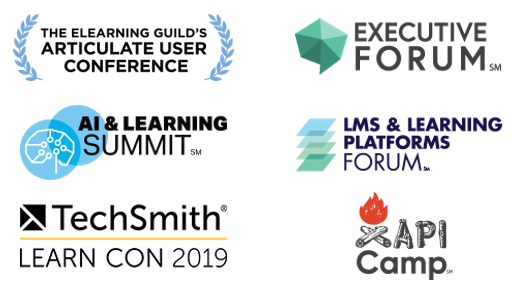David Kelly’s Curated L&D Content for the Week of 9/30/19

David Kelly, Executive Director, The eLearning Guild
This week’s curated content includes links exploring the following:
- A detailed guide on how to become an instructional designer
- How to build effective practice and feedback into your learning programs
- A look at hearables and how they are impacting the future of augmented reality
- Tips on improving your visual design skills
- A new way to engage stakeholders in the measurement conversation
- Getting started with voice-based user interfaces
How to Become an Instructional Designer: The Definitive Guide by Devlin Peck
This post provides both a thorough and brief summary of what it means to be an instructional designer. It’s through in the scope of topics it covers, but brief in that each topic is summarized in only a few paragraphs. It’s a really great overview of foundational knowledge and skills needed by I.D.s. And while the title reflects proactively deciding to become an instructional designer, the resources may be even more valuable to the “accidental” I.D.s that need to quickly learn about the role they just fell into.
How Practice and Feedback Drive Deeper Learning by Patti Shank
You would likely agree that practice and feedback are important for learning. But pressed further on what effective practice and feedback look like in a training or education program and you might not answer as quickly. This post explores how practice and feedback enhance learning and, more importantly, provides four important tips on how to build effective practice and feedback in your learning programs.
Hearables: Broadening AR Definitions by Mike Boland
When people think about augmented reality, they tend to think about visual overlays on the real world. But AR is more than just visually augmenting our real-world experiences. AR can also augment the world through audio and other modes, as this post explores in detail.
How to Improve Your Visual Design Skills by Connie Malamed
Visual design is an important, and too often overlooked, part of an instructional designer’s work. Visual design is its own discipline, and many IDs are unable to dedicate the time needed to fully immerse themselves in the knowledge and skills of the space. That’s what makes posts like this so valuable, as it provides a number of tips that IDs can apply in their daily work that will help enhance visual design skills over time.
Talk management, not measurement by David Vance
Measurement is an important part of an L&D leader’s work, but it can be frustrating to get stakeholders to engage in a conversation around learning metrics. This post provides an alternative conversational technique to engage leaders in the measurement conversation. While the tips are valuable in their own right, I also like the broader approach of meeting leaders where they are, rather than where we want them to be.
10 Steps for Creating a Voice User Interface for Learning by Myra Roldan
Using our voice to interact with computers is rapidly becoming a normalized activity. We talk to machines in our cars, on our wrists, and at our desks, and the interactions are getting more complex every day. It’s natural for many L&D professionals to be looking at the opportunities to use these technologies for learning and performance, but where does one start? This post examines 10 simple steps that can get you started.
Check Out What’s NEW at DevLearn!
The DevLearn Conference and Expo is the one event each year that our industry looks towards to find out how technology is changing the world of learning and performance. DevLearn is the place that the conversations take place that help push our industry forward.
This year we’re providing more space for those conversations to take place, as we’re hosting a number of co-located events that will help push our industry’s strategies and practices to new heights. Check out the events below and visit the website to learn more!


Leave a Reply